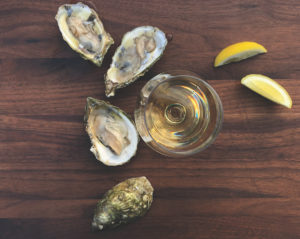
As OysterFest rolls around, it’s time to talk about what you should drink with those briny, sparkling Wellfleets. The classic wines to go with oysters have lively acidity and pronounced minerality. You might well ask what the heck does that mean?
The answer is not complicated. It means they are crisp and refreshing. Their flavors arc toward citrus. Their minerality can hint at a taste of brine. Three classic candidates that meet these criteria are muscadet, Chablis, and Sancerre. Champagne, without a doubt, is always good with oysters, too.
Muscadet (not to be confused with moscatel, moscato, or muscat — which is a sweet dessert wine) comes from the Loire Valley in France and is made from the white melon de Bourgogne grape. It is bright and crisp, and it’s also a great value, with very good bottles available for around $15.
Chablis is made from chardonnay grapes grown in the northernmost part of Burgundy. It can range in complexity, but always with good minerality. The fruit is grown on mineral-rich clay soil that contains marine fossils, including oyster shells. Chablis tends to have only a touch of oak, which makes it super delicious. However, because it’s a Burgundy, it can be pricey — expect to pay upwards of $25 for a bottle.
Sancerre is sauvignon blanc from the Loire Valley. Its minerality reflects the fact that the soils in the Loire also contain traces of ground shells, as the area was an ancient seabed.
All three of these French wines have delicious analogs in the New World. As a substitute for Chablis, forget about those big green jugs of “chablis” your parents swilled in the 1970s. Try an unoaked chardonnay. There are many good ones from California, Oregon, Australia, and South Africa. They will usually be less pricey but still make knockout companions for oysters. Sauvignon blanc is easy to find, and there are tasty bottles in the $10 to $12 dollar range, though if you can, it’s worth splurging a bit — $25 will give you a fuller, more interesting experience.
Now a caveat. These wines are all good matches for oysters served alone, with a spritz of lemon, or with the classic mignonette (minced shallots and black pepper, stirred into good vinegar). But what if you are having cocktail sauce instead? Or what if you are preparing fried oysters (heresy to some, I know) and dunking them in tartar sauce? I’d suggest a rosé with a bit of body to stand up to the ketchup, horseradish, and tabasco of cocktail sauce. But once you’re into the tartar sauce, I’d go for a fuller bodied chardonnay over a sauvignon blanc. With fried oysters, you could leave the wine entirely and have a nice cold beer. An IPA is fine, or keep it local by trying the dry and lemony Kolsch from Devil’s Purse.
Whatever you pour into your glass this weekend, raise it and offer a toast to the future. May it return to us the oyster-y excess of the real OysterFest next year.



